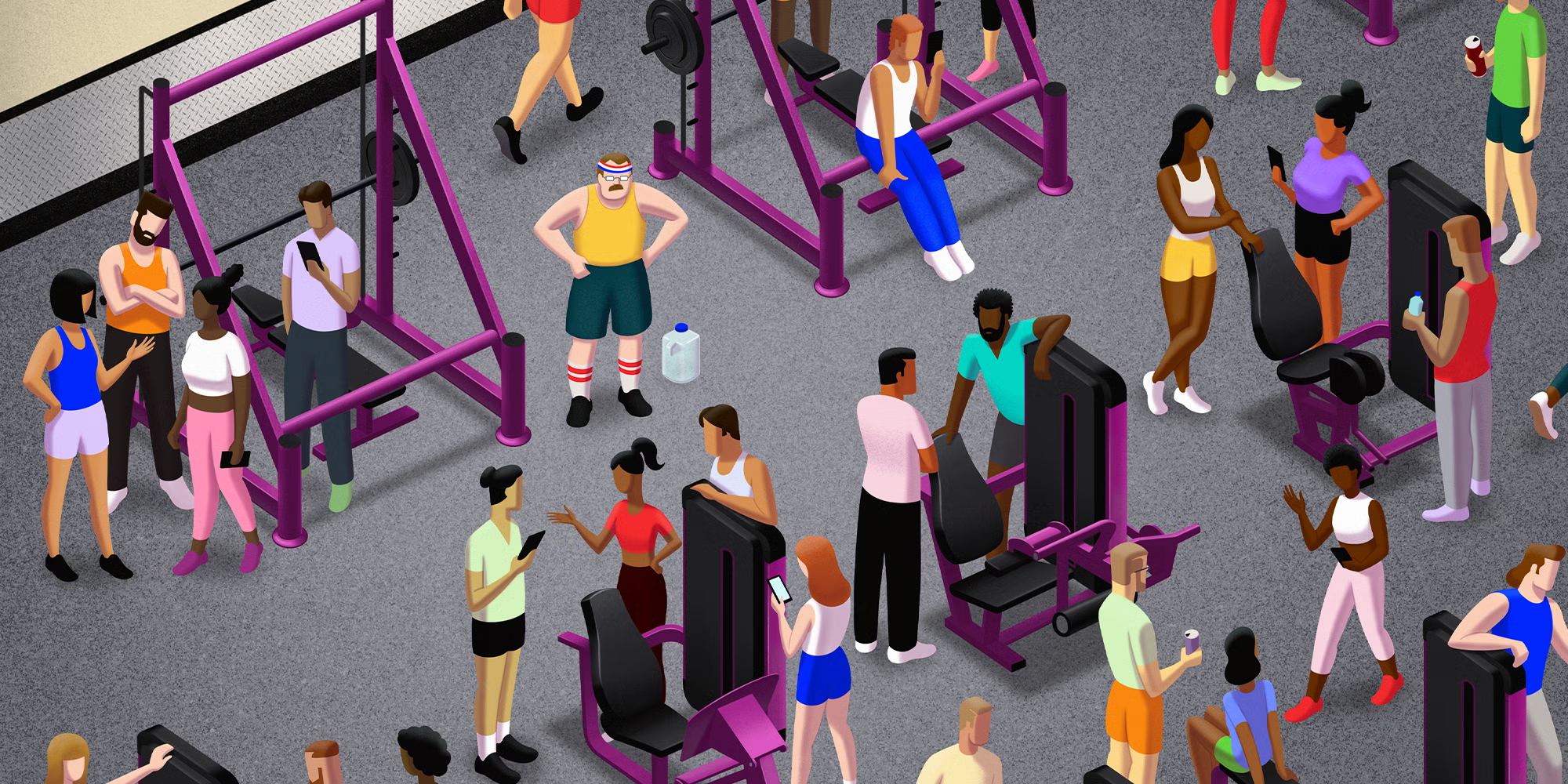The swolest generation

Gen Z loves the gym. That’s a big problem for gyms.
Every day after school growing up, Britt Taylor would hit the studio. When she wasn’t dancing competitively, she was on the cheer squad or running track. Now 20 and in college, Taylor belongs to two gyms in her hometown of Boca Raton, Florida, and goes five or six times a week. Though she has a busy schedule as a student studying communications, fitness has become one of her top priorities.
In a 2023 survey from McKinsey, more than half of Gen Z respondents said fitness was a very high priority for them. Forty percent of all respondents said the same.
Like Taylor, these young people aren’t just working out at home — they are helping drive up gym attendance. Surveys by the fitness organization Les Mills found that the share of adults who reported going to the gym increased to 32% in 2019 from 27% in 2013. Other surveys and data from companies like Placer.ai and ABC Fitness similarly suggest more people are going to the gym more regularly than they did several years ago. And the memberships of chains like Planet Fitness have exploded — that brand gained more than 4 million new members from 2019 to the end of 2023.
“As much as we think that our country is obese or unhealthy, there’s another whole side who are into their fitness,” Taylor said. “My generation is taking that to the next step.”
In particular, Gen Z loves to lift weights. In a 2022 CivicScience survey, strength training was the most common type of workout cited by Gen Z respondents. And in a 2023 survey in the American College of Sports Medicine’s journal, it was ranked the second-most-popular fitness trend of the year. Taylor told me that strength training now makes up 90% of her routine. “There’s a switch from my mom, who’s been into cardio and being tiny and thin,” Taylor said. “Now girls want big butts and big biceps.”
The quest to get swole is one reason young people are showing up at the gym in droves: Weightlifting requires special equipment that is tricky to fit into a small apartment. But there are other pulls: At a time when meeting people can be challenging, it’s an easy way to put yourself out there and make friends. Gyms are quickly becoming Gen Z’s favorite hangout spot — but there’s just one problem with the fitness boom. Chains like Planet Fitness rely on members never showing up; the gyms aren’t built for Gen Z.
Much of Gen Z’s exercise bug comes from social media, where gymfluencers have taken off. YouTube said that the number of fitness videos on its platform grew more than fivefold in 2020 and that they’ve remained popular. Hundreds of personal trainers, amateur bodybuilders, and fitness-class instructors like Kayla Itsines (16 million followers) and Christian Guzman (1 million followers) have built loyal fanbases online by sharing their workout routines, swapping exercise tips, and showing off their tanned and toned muscles.
While fitness-influencer culture is generally positive and aimed at educating people about their health, it can drift to the extreme. “Grindset” influencers, whose content converges the male-oriented online realm of the manosphere with fitness-adjacent hustle-and-grind culture, have also exploded. Their mission? To self-optimize with routines like waking up at 4 a.m., running 18 miles fuelled only by black coffee, and listening to a business podcast at three times the speed.
On the other end of the influencer spectrum are trainers like Whitney Simmons (4 million followers) and Simeon Panda (8 million followers) who have helped bust the myths that lifting weights is only for men or that it just makes women bulky. “If we think of the default approach to exercise, it almost always involves some form of cardio: walking, running, elliptical machines, spinning, cycling,” the fitness influencer Casey Johnston wrote in her popular newsletter She’s A Beast, adding, “Now, emerging evidence suggests that, if anything, these exercise paradigms will soon be flipped.”

Johnston used to think the low-calorie, high-cardio lifestyle was the way to go — but she eventually got frustrated that she wasn’t seeing the physical results she had hoped for. Weightlifting helped her feel and look strong without needing to sacrifice her diet.
Sarah Ryan, a personal trainer for the fitness app Ladder, thinks the boom in weightlifting simply stems from people learning that it’s good for you. “Building muscle is going to favor a healthier body composition,” Ryan said. “The more muscle mass you have, which is metabolically active tissue, the healthier you’re going to be.”
That’s partly what motivated Amrita Bhasin to try weightlifting. The 23-year-old first set foot in a gym when she moved from California to Portland, Maine, at the end of 2023. Previously, Bhasin played tennis, pickleball, and field hockey. But after moving to a colder climate, she could no longer rely on her usual outdoor exercise routine. “It didn’t make sense for me to go to the gym just to run on the treadmill,” she said. That would be boring. So, inspired and encouraged by her male friends who started strength training during the pandemic, Bhasin started experimenting with lifting weights. “I’d grown up knowing the benefits of it for bone density,” she said, “but I don’t have a whole lot of female friends who weightlift.”
The winter in Maine gave her the opportunity to learn. When she started seeing the number on the weights go up, she became hooked. “When you’re 80, the people who will be the most mobile will be those who did strength training when they were young,” she said.
“There never used to be this education around it, for women especially,” she said, adding, “More women need to be doing this.”
Taylor also got into weightlifting after trying it out during the pandemic. “Strength training has the most return on investment,” she told me when I asked why she likes it. “You need continuous commitment in order to see results.”
After seeing her biceps grow and her posture improve, Taylor started documenting her workout routines on a private Snapchat story for her friends. “I had a lot of people reaching out wanting to know what I do, what I eat. Then I thought maybe I need to showcase this more,” she told me. Now Taylor posts her workouts and other fitness-related content on Instagram, where she has amassed over 30,000 followers. She also writes about health on her blog Biceps By Britt. “My goal is to show girls my age that it’s good to lift heavy weights. It’s good to eat high protein,” she said.
The health perks aren’t the only reason young people are flocking to the gym — it’s also one of the few places people regularly visit where they can meet new people. “It’s where their friends hang out; there’s a sense of community here,” said Jim Thomas, the founder and president of Fitness Management USA, a management-consulting firm specializing in the fitness and health club industry.
In a 2021 McKinsey survey, 70% of fitness consumers said they missed their health clubs as much as their friends and family during lockdowns. And in a 2023 survey by Les Mills, two-thirds of Gen Zers said the social aspect was something they looked for in a gym.

I rarely go to the gym alone anymore,” Bhasin told me. “It’s always either meeting other people there or going with other people.” Where she lives in Portland, it’s hard to find places to hang out with friends. “You go to a coffee shop, and even if you spend $8, there will be a sign there that says the maximum amount of time you can stay is two hours,” she told me. Restaurants in her area also close early in the winter. “My gym is open 24 hours, so we don’t feel that pressure to have to leave.” She and her friends will hang out and catch up after their workouts or use the gym as a meeting place before heading to other activities.
Many gyms are responding to the demand by redesigning spaces with better hangout spots. “Gyms have noticed that members also want a social aspect to the gym experience,” said Renel Scarlett, a co-owner of The Works Health Club, an independent gym that focuses on building community, “whether that’s running clubs, a coffee or refuel bar area where you can sit down and have a chat before class or after they train.”
Life Time, a national health-club chain, has leaned into this model in recent years. When its membership dropped during the pandemic, it pivoted its business model to prioritize luxury social amenities like coworking spaces and pickleball courts, charging members more for them. The chain has added about 65,000 new members since 2021, and in 2023 it grew its revenue by more than 20%.
In some ways, it’s a return to form. Fitness and socializing have long been combined. Country clubs, whose original facilities included tennis courts, polo fields, racetracks, and baseball diamonds, were an important part of the American social scene in the 20th century. And local sports leagues and clubs have long filled the gaps left by the decline in other kinds of social groups. The only hang-up is that some gyms aren’t prepared for the influx of patrons. In fact, many gyms actually depend on their members not showing up.
Planet Fitness, the most popular gym franchise in the US, has on average 6,500 members per gym. But most of its gyms hold only about 300 people. In 2022, it told CNN that 60% of its members didn’t visit the gym in a 30-day stretch. But they keep paying — the low monthly rate doesn’t incentivize people to cancel, so the non-attendees subsidize the cost for those who do.
However, this model is being stretched to its limit. Amelie Desai, a fitness and lifestyle influencer in California, attends her local gym up to six times a week. “Over the past three years I’ve noticed a significant increase, especially in young people, going to the gym,” Desai told me. “The weight section and the treadmills are always very busy, whereas the other random machines, like the bicycles, no one’s ever on those,” she said.

Scarlett, the Works Health Club co-owner, said most gyms he knows are increasing their weight areas because of demand. “I would say every five to 10 years, depending on what’s trending, gyms will switch up the management layout,” he told me.
But even with a new layout, the low-cost, high-value gym model doesn’t work when too many people start regularly attending the gym. Can you imagine if 6,500 people tried to show up at one Planet Fitness location all at once? Taylor got so frustrated at how crowded her last gym was that she ditched it for one with more space. “I would be waiting for the barbell for 30 minutes and just wasting my time,” she said.
A report from the Health & Fitness Association said gyms with membership bases that exceeded their optimal capacity saw a 20% drop in member satisfaction from 2022 to 2023. “The churn rate for low-cost gyms can be as high as 40% annually,” Bassem Mostafa, a lead market analyst covering the gym and fitness industry and the owner of GlobeMonitor Market Research Agency, told me, citing his company’s research.
Sometimes the math just doesn’t add up. It could be why Planet Fitness is raising its price for the first time in nearly 30 years. This summer, the chain bumped up its rate to $15 a month from $10 after it reported weaker-than-expected first-quarter revenue. Gen Z’s love of the gym might just drive more gyms to rethink their business models.
For this generation, the gym isn’t just a place to simply shed a few pounds; it’s a hub for improving their mental health, physical strength, and social connections. “It’s not about how you look,” Desai said. “It’s about how you feel.”
Now it’s on the fitness industry to catch up.






